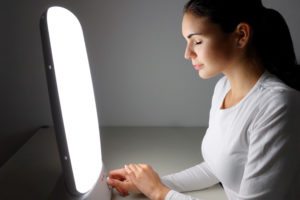 Generally, most people with Seasonal Affective Disorder (SAD) begin treatment with light therapy in the early fall, when it typically becomes cloudy in many regions of the country. Treatment usually continues until spring, when outdoor light alone is sufficient to sustain a good mood and higher levels of energy.
Generally, most people with Seasonal Affective Disorder (SAD) begin treatment with light therapy in the early fall, when it typically becomes cloudy in many regions of the country. Treatment usually continues until spring, when outdoor light alone is sufficient to sustain a good mood and higher levels of energy.
If you typically have fall and winter depression, you may notice symptoms during prolonged periods of cloudy or rainy weather during other seasons. You and your doctor can adjust your light treatment based on the timing and duration of your symptoms.
If you want to try light therapy for nonseasonal depression or another condition, talk to your doctor about how light therapy can be most effective.
During Light Therapy
During light therapy sessions, you sit or work near a light box. To be effective, light from the light box must enter your eyes indirectly. You can't get the same effect merely by exposing your skin to the light.
While your eyes must be open, don't look directly at the light box, because the bright light can damage your eyes. Be sure to follow your doctor's recommendations and the manufacturer's directions.
Light therapy requires time and consistency. You can set your light box on a table or desk in your home or office. That way you can read, use a computer, write, watch TV, talk on the phone or eat while having light therapy. Stick to your therapy schedule and don't overdo it.
Three Key Elements for Effectiveness
Light therapy is most effective when you have the proper combination of light intensity, duration and timing.
Intensity. The intensity of the light box is recorded in lux, which is a measure of the amount of light you receive. For SAD, the typical recommendation is to use a 10,000-lux light box at a distance of about 16 to 24 inches (41 to 61 centimeters) from your face.
Duration. With a 10,000-lux light box, light therapy typically involves daily sessions of about 20 to 30 minutes. But a lower-intensity light box, such as 2,500 lux, may require longer sessions. Check the manufacturer's guidelines and follow your doctor's instructions. He or she may suggest you start with shorter sessions and gradually increase the time.
Timing. For most people, light therapy is most effective when it's done early in the morning, after you first wake up. Your doctor can help you determine the light therapy schedule that works best.
We Can Help
Questions about SAD or depression? If you or a family member has health concerns, call VITAL WorkLife anytime, day or night. We can help you evaluate the seriousness of your symptoms and suggest different options of care.
MEMBERS
If you are a member of one of our solutions, give us a call to speak with a representative; we’re available anytime, day or night.
- EAP members: call 800.383.1908
- Physician Well Being Resources members: call 877.731.3949
FOR MORE INFORMATION
For more information about our comprehensive suite of well being solutions, call 800.383.1908.
Source: Light Therapy What you can expect. Mayo Clinic: February 8, 2017. https://www.mayoclinic.org/tests-procedures/light-therapy/details/what-you-can-expect/rec-20197460. Retrieved October 12, 2017


